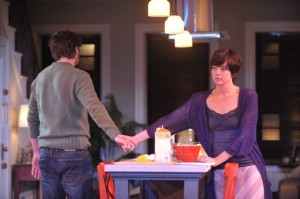Whether to Re-Up on Marriage – FIFTY WORDS at Everyman
Theater Reviews Page | Previous Theater Review | Next Theater Review
Whether to Re-Up on Marriage – FIFTY WORDS at Everyman
Published on BroadwayWorld.com January 23, 2012
When marriages go critical, as marriages will from time to time, the scenes and fights that embody the crisis will seldom be straightforward affairs. As playwright Michael Weller intelligently conveys in Fifty Words, his recent off-Broadway success receiving its inaugural Baltimore production at Everyman Theatre, the emotions that will have led to the crisis were inevitably complicated things, and the crisis’ unfolding will be consistent with those emotions. Except in the most empty marriages, no matter what the parties may have done to each other, there are still ties of love holding them together, however tenuously, in near-equipoise with the forces pushing them apart.
In living through these crises, then, both forces, the centripetal and the centrifugal, must have a part. To the observer, it might seem laughably incoherent, but actually it is just the way things are at such moments.
There are two ways a dramatist can approach this reality. He/she can make of the complexity a dramatic structure unto itself – one in which there is no truth but the struggle between the parties, and in which each mode the parties have of relating to each other, whether it be hugging on the one hand or screaming and throwing things on the other, is just another form of struggle for mastery, no more distinct, at bottom, than thrust is from parry. That was Edward Albee’s approach in Who’s Afraid of Virginia Woolf?.
Fifty Words, though facially somewhat similar, actually takes the opposite tack, namely to treat seriously the contradictory emotions of the participants in the scene, to make the scene no more (or less) dreadful or dramatic than such a scene would be in real life, and to show the parties’ incoherence and ambivalence for what it is: the natural result of the messy lives lived to bring them to such a moment. It is a canny approach, because few of us will attain much maturity without having lived through such scenes, and the shock of recognition will be considerable.
The subject being a fairly universal experience, the two characters in this two-character play are Everymen of a sort – at least of the sort who inhabit New York brownstones and send their children to private schools. Adam (Clinton Brandhagen) is an architect, Jan (Megan Anderson) a former dancer turned freelance data-miner. They are likeable, even endearing, without being terribly distinct. Their nine-year-old son Greg, never seen onstage, may be slightly neurotic and/or afflicted with mild ADD.[1] What ails Adam and Jan’s marriage likewise is fairly typical: the inevitable fading of sexual novelty, the disappointments and pressures of their careers, the stresses of parenthood, and an affair Adam has been having which, not very coincidentally, chooses the night of their son’s first out-of-home sleepover to become known.
Even before Adam’s affair tumbles out of the closet, we see the ambivalent way they treat each other, in love but not always loving, finding it difficult to connect. Once the mistress is acknowledged, however, the contradictions reach a fever pitch. She throws things that break; she gets a splinter in her foot; he helps get the splinter out; they make love; she orders him to leave the home, etc. He extols the way the mistress looks out for his feelings (as opposed to Jan, who he asserts does not), but then seems willing to promise whatever is necessary to revive the marriage – begging the question why, at least a little.
Whether the marriage actually will be saved is not revealed by the fadeout, though the play ends on a hopeful note. But it is evident that if the two of them remain together, it will not be so much the saving of the extant marriage as effectively a third marriage for both of them, succeeding the hotly sexual early infatuation and the stage in which they built up a home and a family.
Marriages, Weller seems to be saying, are actually multiple successive events, for which a couple must consciously re-up every few years. The title refers to the supposed number of words in Eskimo for snow (though I have also heard that this lexicographical multiplicity is an urban legend), and to a suggestion by one of the characters that there should be a similar number of terms for love (perhaps one for each iteration of a marriage).
I’ve not seen the various productions of Fifty Words (New York, Toronto, and Chicago, at least), but it seems that the play has undergone some changes since its 2008 premiere. Everyman gives it a solid rendering with two veteran company members doing the honors in workmanlike fashion, fully and convincingly inhabiting two average professional-class New Yorkers living through a garden-variety crisis. You believe in these characters from the outset, without finding either of them very remarkable, which I think is exactly right for this play. Director Donald Hicken keeps the action humming and the emotions real. And the set by Timothy Mackabee is a marvel, a straight shot through the fuselage of a brownstone with everything from a fridge to board games on display.
______________
[1] One reader has suggested that I missed cues that the son’s condition is actually Asperger’s. Could be; that is, it could be that we’re meant to think that. What I read into it was that the parents were being bombarded with a lot of worrisome but ambiguous information of the sort that not always, but usually signifies merely that a child is having a rough patch, and, at worst, is probably at the benign end of the spectrum of horribles.
Copyright (c) Jack L. B. Gohn except for photograph
Theater Reviews Page | Previous Theater Review | Next Theater Review
